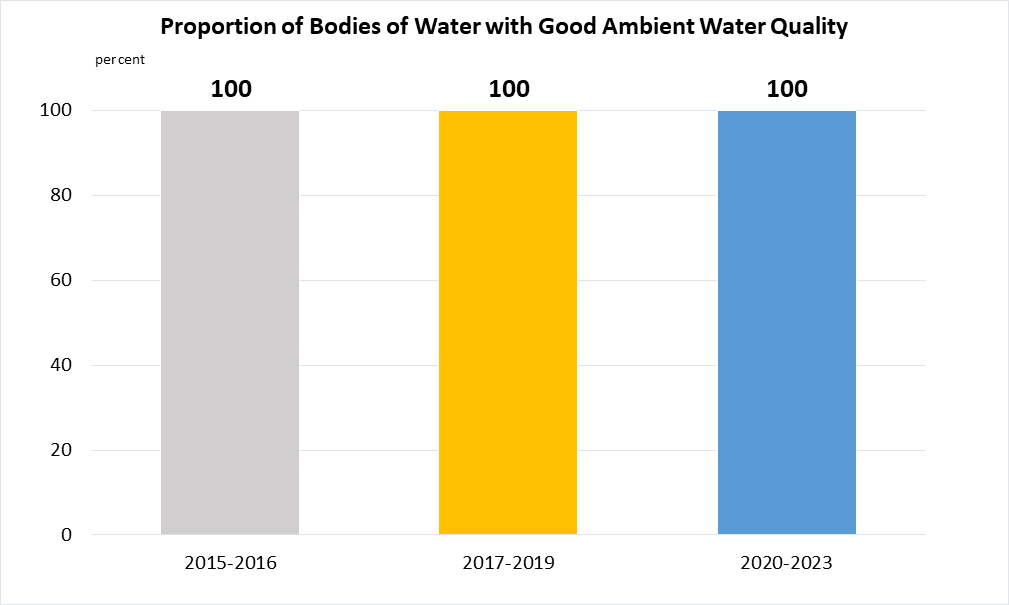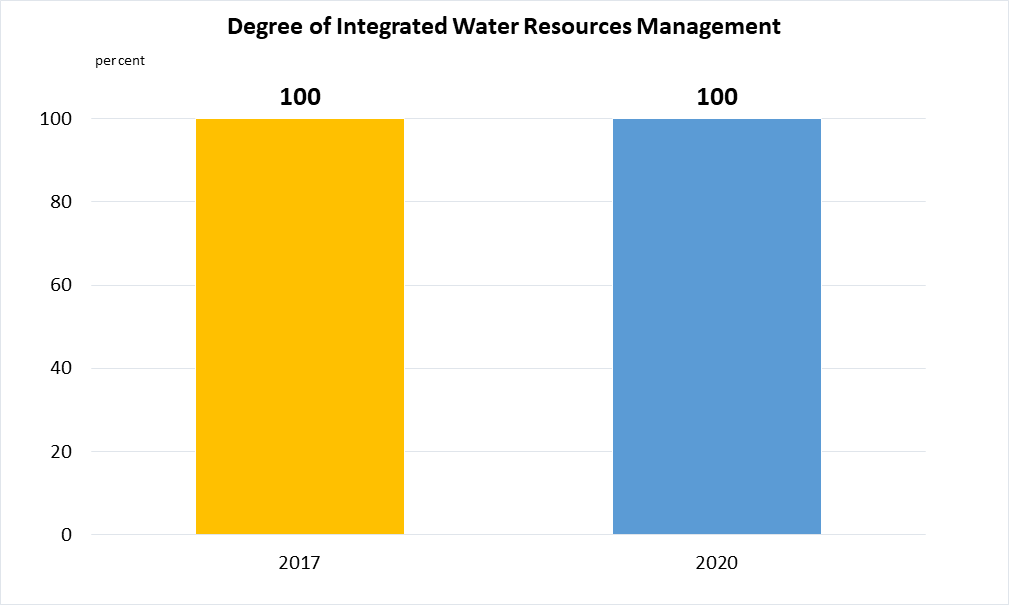Sustainable Development Goals
Targets and Indicators with Data Availability
Note: The data may be updated periodically as more information become available.
 |
Safe and Affordable Drinking Water
By 2030, achieve universal and equitable access to safe and affordable drinking water for all.
|
Indicator 6.1.1 | Proportion of population using safely managed drinking water services
|
Proportion of population with access to improved drinking water sources is 100% for the data time period since 2000.
|
 |
 |
End Open Defecation and Provide Access to Sanitation and Hygiene
By 2030, achieve access to adequate and equitable sanitation and hygiene for all and end open defecation, paying special attention to the needs of women and girls and those in vulnerable situations.
|
Indicator 6.2.1 | Proportion of population using (a) safely managed sanitation services and (b) a hand-washing facility with soap and water
|
Proportion of population with access to improved sanitation is 100% for the data time period since 2000.
Data do not cover access to hand-washing facility with soap and water.
|
 |
 |
Improve Water Quality, Wastewater Treatment and Safe Reuse
By 2030, improve water quality by reducing pollution, eliminating dumping and minimizing release of hazardous chemicals and materials, halving the proportion of untreated wastewater and substantially increasing recycling and safe reuse globally.
|
Indicator 6.3.1 | Proportion of domestic and industrial wastewater flows safely treated
|
Proportion of domestic and industrial wastewater flow safely treated has been 100% since 2015.
|
|
 |
Indicator 6.3.2 | Proportion of bodies of water with good ambient water quality
|

Data reflected the overall performance for the specified time periods.
|
|
 |
 |
Increase Water-Use Efficiency and Ensure Freshwater Supplies
By 2030, substantially increase water-use efficiency across all sectors and ensure sustainable withdrawals and supply of freshwater to address water scarcity and substantially reduce the number of people suffering from water scarcity.
|
Indicator 6.4.2 | Level of water stress: freshwater withdrawal as a proportion of available freshwater resources
|
As a densely populated small island-city, Singapore has limited natural freshwater resources and limited land to capture and store rainwater. As such, Singapore will always be water stressed. However, through careful planning and innovation, we have been able to build a robust, diversified and sustainable supply of water with our Four National Taps, which includes NEWater (i.e. recycled used water) and desalinated water. We have also undertaken several initiatives to manage water demand and promote water conservation to ensure the sustainability of our water resources.
|
|
 |
Implement Integrated Water Resources Management
By 2030, implement integrated water resources management at all levels, including through transboundary cooperation as appropriate.
|
Indicator 6.5.1 | Degree of integrated water resources management
|

Vast majority of Integrated Water Resources Management (IWRM) elements are fully implemented, with objectives consistently achieved, and plans and programmes periodically assessed and revised.
|
|
Indicator 6.5.2 | Proportion of transboundary basin area with an operational arrangement for water cooperation
|
Not applicable as Singapore does not share any transboundary basin area with other countries.
|
|
 |
 |
Protect and Restore Water-Related Ecosystems
By 2020, protect and restore water-related ecosystems, including mountains, forests, wetlands, rivers, aquifers and lakes.
|
Indicator 6.6.1 | Change in the extent of water-related ecosystems over time
|
The area of mangroves in Singapore is 9.31km2 in 2018.
|
|
 |
Expand Water and Sanitation Support to Developing Countries
By 2030, expand international cooperation and capacity-building support to developing countries in water- and sanitation-related activities and programmes, including water harvesting, desalination, water efficiency, wastewater treatment, recycling and reuse Technologies.
|
Indicator 6.A.1 | Amount of water- and sanitation-related official development assistance that is part of a government-coordinated spending plan
|
Not applicable. Singapore does not receive Official Development Assistance.
|
|
 |
Support Local Engagement in Water and sanitation Management
Support and strengthen the participation of local communities in improving water and sanitation management.
|
Indicator 6.b.1 | Proportion of local administrative units with established and operational policies and procedures for participation of local communities in water and sanitation management
|
As a city state, Singapore’s government carries out both national and local functions. We have high levels of participation by local communities in the following areas:
(i) Urban drinking water
Singapore's National Water Agency, PUB has partnered with the private sector to Design, Build, Own, and Operate (DBOO) some of our desalination plants, which allows PUB to tap on their expertise and resources to deliver drinking water solutions. In addition, the public was consulted on any changes to be made for the Code of Practice on Water Services (SS 636:2018) which had to be approved by the Building and Construction Standards Committee comprising members in their individual capacity or as representatives of Professional Bodies, Trade Associations and public agencies.
(ii) Urban sanitation
PUB’s Code of Practice on Sewerage and Sanitary Works was developed and amended with consideration of feedback and in consultation with Industry (e.g. Professional Bodies, Trade Associations, sewerage pipe/product manufacturers and other public agencies).
(iii) Water resources planning and management
PUB collects and addresses public feedback received on Environmental Impact Assessments (EIA) conducted for water infrastructure projects in ecologically sensitive areas. Nature groups are also consulted as part of the EIA process.
|
|